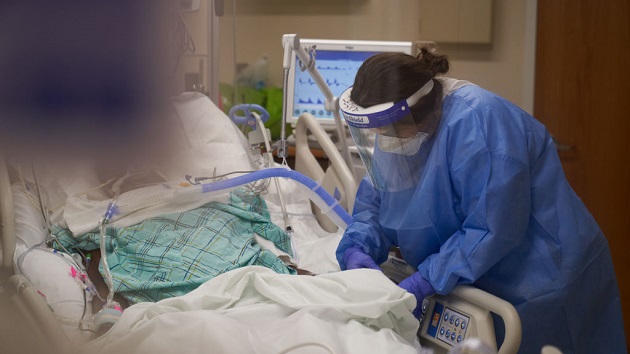(NEW YORK) — COVID-19 hospitalizations are continuing to increase in the United States, according to the Centers for Disease Control and Prevention.
For the week ending Aug. 5, COVID hospitalizations increased 14.3% from 9,026 to 10,320 weekly hospitalizations, data from the federal health agency updated Monday shows.
While the percentage jump is in the double digits, the absolute numbers are still quite low. Weekly hospitalizations during the omicron wave peaked at 150,674 in January 2022.
“We have to remember that we’re still dealing with numbers that are far less than what we’ve seen for the pandemic,” said Dr. John Brownstein, an epidemiologist and chief innovation officer at Boston Children’s Hospital. “We have to zoom out to look at our experience for the entire pandemic, to understand that what we’re dealing with now is far from any crisis that we’ve experienced with previous waves.”
“While a percentage [increase] may seem scary, we’re still dealing with absolute small numbers,” Brownstein, an ABC News contributor, added.
COVID-19 hospitalizations have been rising over the last several weeks, increasing 12.5% last week and 12% the week before. Brownstein noted that the rate of increase week-over-week is also not as steep as seen during previous waves.
Data also showed that COVID-19 deaths have slightly increased in July, rising to 473 the week of July 15 — the latest date for which complete data is available. However, experts say this is expected after a rise in hospitalization and reporting delays may result in death numbers shifting in the coming weeks.
“Proportionately, it makes sense that when you have increased transmission, you will see proportionately some increase in hospitalizations, and you will see some increase in deaths,” Brownstein said. “But there’s a decoupling that is happening between cases and hospitalizations, where a jump in cases doesn’t necessarily mean as big a jump in hospitalizations and deaths.”
Brownstein said there could be several factors behind the increase including waning immunity, a reduction in mitigation measures and more people gathering indoors.
“It doesn’t mean that we shouldn’t be vigilant about COVID,” he said. “It also doesn’t mean that we shouldn’t look for opportunities to reduce our personal risk, and to make sure that we’re, up to date on immunizations. But this is more likely going to be you know, what we’ll experience going forward with COVID.”
All currently circulating subvariants are related to XBB, a descendant of omicron. A newer variant known as EG.5 now makes up an estimated 17% of new cases, according to the CDC.
Currently, there is no evidence to suggests that EG.5 causes more severe disease or is significantly more infectious than previous variants.
Brownstein said some of the concern may be due to surges seen with variants in the past such as the delta variant in summer 2021, leading to a sounding of the alarm.
“But each new variant so far that has come through has subsequently had less of a population impact,” he said. “Now, is it possible we may see one in the future that is worthy, a real concern? Absolutely. But overall, we’ve seen a dampening of effect over the last several variants that have come through.”
Copyright © 2023, ABC Audio. All rights reserved.












